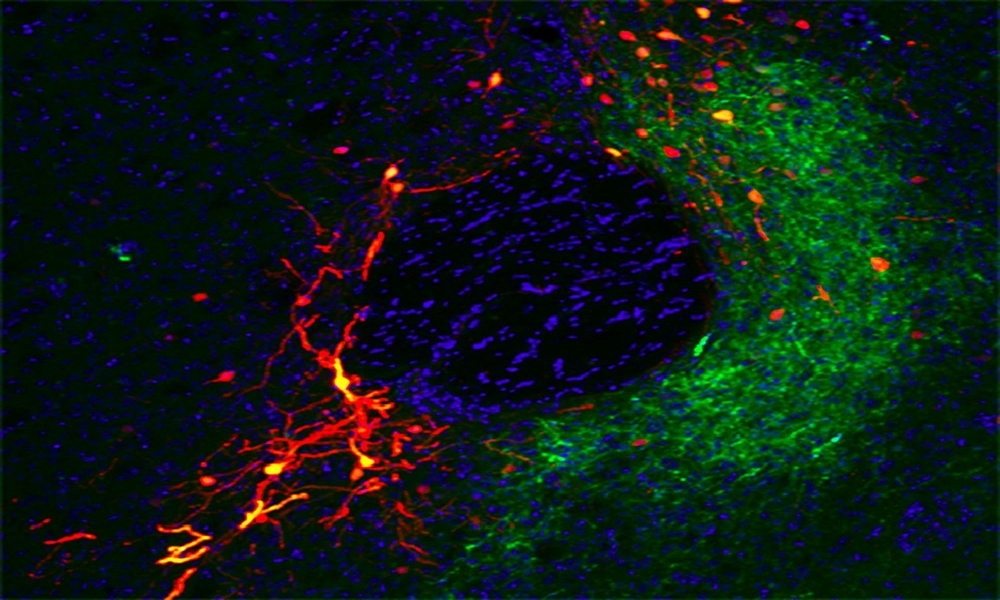
WELCOME TO THE BARAM LAB WEBSITE
Our lab is focused on the influence of early-life experiences on developing brain circuits and on the underlying plasticity mechanisms that promote health or disease. We probe these at molecular, cellular, circuit and functional/behavioral levels using viral- and chemo-genetic techniques, in vivo electrophysiology and imaging, and epigenomic and single-cell transcriptomic methodologies.
Current Topics of Research in the Lab Include
a) How early-life adversity/stress provokes anhedonia, and the underlying perturbations of the maturation of reward/pleasure circuitry.
b) How early-life adversity/stress provokes spatial memory deficits and the transcriptional / epigenomic mechanisms that re-program hippocampal neurons and circuits
c) How prolonged early-life seizures, especially those associated with fever, disrupt the maturation of hippocampal circuits and memory processes
d) Intra-individual methylomics in rodents and humans as predictive biomarkers of early-life adversity-induced cognitive and emotional problems
e) How multiple concurrent acute stresses, such as occur in mass shootings and natural disasters, impact memory processes in males and females.
Tallie Z. Baram
Tallie Z. Baram, MD, PhD is the Danette Shepard, Bren and distinguished professor at UCI School of Medicine. She is a developmental neuroscientist and child neurologist who has focused her research efforts on the influence of early-life experiences on brain maturation and the underlying mechanisms. Throughout her career, Baram has studied this topic in two broad contexts, pertaining, respectively, to stress-related and activity-dependent plasticity: a) How early-life experiences including adversity/stress promote enduring vulnerability to cognitive and emotional disorders; and b) how early-life seizures, especially those associated with fever, can convert a normal brain into an epileptic one.
A common thread of Baram’s research program is the use of multiple and trans-disciplinary technologies and levels of analysis including molecular, cellular and circuit methods and cross-species studies. She employed these to uncover how adverse early-life experiences sculpt memory-, stress- and reward-related circuit maturation. In this context, she has uncovered novel types of adversity in humans and rodents (unpredictable sequences of sensory signals) that contributes to aberrant circuit maturation (e.g., Birnie & Baram, Science, 2022). Additionally, she has focused on the overarching hypothesis that neuronal populations and projections expressing the stress-related peptide CRH may be particularly vulnerable to early-life adversity, resulting in disrupted operations of networks that include them. This notion has led to identification of novel CRH+ reward-circuit projections, and assessments of established CRH-cell populations using single-cell transcriptomics.
The Baram lab has pioneered naturalistic, translationally-relevant paradigms of early-life adversity (ELA) that have been embraced world-wide, and demonstrated the causal influence of ELA on cognitive and emotional health via convergent actions of multiple mediators (including locally-synthesized CRH). More recently, through collaborative work in her NIH funded Conte Center and a recent collaborative award with CHOC from the California Initiative to Advance Precision Medicine, she is translating her discoveries back to the clinic. Her work has been published in leading journals (e.g., Science, Nature Rev Neurosci, Nature Medicine, Nature Neurosci) and cited over 30,000 times (H = 96, google scholar). Baram’s discoveries have been universally recognized, apparent from awards including the NIH NINDS Javits Merit Award, premier Research Awards of the AES (2005), CNS (2013), ANA (2014) and AAN (2018), and a Public Impact Award (CNLM, 2022).
Baram strives to contribute to the scientific community by, for examples, chairing NIH study sections and involvement in editorial boards and professional organizations, including ACNP. She is passionate and committed to mentoring, with emphasis on scientific rigor and inclusivity: Baram is PI of one of only two NIH-funded T32s focused on Epilepsy, and mentor of several recent K99 and F30 awardees. Many of her trainees, from diverse racial and geographical backgrounds are now contributing independently and successfully to our understanding of the brain in health and disease.
Lab News:
DECEMBER 2024 | Mason and Dr. Chen, in collaboration with Dr. Nicholas J. Justice, developed and validated a new transgenic mouse, Crhr1-FlpO, that provides highly selective genetic access and manipulation of CRHR1- expressing cell populations. This paper is available in Brain Struct Funct: Targeting corticotropin- releasing hormone receptor type 1 (Crhr1) neurons: validating the specificity of a novel transgenic Crhr1-Flp0 mouse (link to paper).
Lara, Matt, and Dr. Chen identified a corticotropin-releasing hormone (CRH) expressing GABAergic projection from the basolateral amygdala (BLA) to nucleus accumbens (NAc) that influences reward behaviors in males, but differs structurally and functionally in females, uncovering potential mechanisms for the profound sex-specific impacts of ELA on reward behaviors. This paper is available in bioRxiv: Sex-and stress-dependent plasticity of a Corticotropin Releasing Hormone / GABA projection from the basolateral amygdala to nucleus accumbens that mediates reward behaviors (link to paper).
Jen and Kevin assessed the functional consequences of focal, adult PTEN deletion, focusing on its pro-epileptogenic potential. Focal, unilateral deletion of PTEN in the adult dentate gyrus suffices to provoke time-dependent emergence of a hyperexcitable circuit generating hippocampus-origin, generalizing spontaneous seizures, providing a novel model for studies of adult-onset epileptogenesis. This paper is available in Neurobiol Dis: PTEN deletion in the adult dentate gyrus induces epilepsy (link to paper).
SEPTEMBER 2024 | In this collaboration, they sought to investigate the sex-specific consequences of early-life unpredictability on the limbic network, focusing on the hippocampus and the amygdala. Exposure to unpredictability in early life has persistent implications for the functional operations of limbic circuits, differing for males and females. Further, impacts of early-life unpredictability were independent of other risk factors including lower household income and negative life events, indicating distinct consequences of early-life unpredictability over and above more commonly studied types of early life adversity. This paper is available in bioRxiv: Sex-specific effects of early life unpredictability on hippocampal and amygdala responses to novelty in adolescents (link to paper).
AUGUST 2024 | In this review, Matt focuses on the consequences of a one-week exposure to adversity during early postnatal life in the rodent, the spectrum of the ensuing memory deficits, and the mechanisms responsible. He highlights molecular, cellular and circuit mechanisms using convergent trans-disciplinary approaches aiming to enable translation of the discoveries in experimental models to the clinic. This review is available in Neurobiol Stress: Enduring memory consequences of early-life stress / adversity: Structural, synaptic, molecular and epigenetic mechanisms (link to paper).
Jen and Kevin assessed the functional consequences of focal, adult PTEN deletion, focusing on its pro-epileptogenic potential. Focal, unilateral deletion of PTEN in the adult dentate gyrus suffices to provoke time-dependent emergence of a hyperexcitable circuit generating hippocampus-origin, generalizing spontaneous seizures, providing a novel model for studies of adult-onset epileptogenesis. This paper is available in Neurobiol Dis: PTEN deletion in the adult dentate gyrus induces epilepsy (link to paper).
JULY 2024 | Congratulations to Rachael for defending their PhD!
Annabel and collaborators confirm and extend the translational value of these rodent models (ELA) by verifying the effectiveness of computational modeling in distinguishing independent features of reward sensitivity and learning rate that complement the probabilistic reward task’s signal detection end points. Together, these metrics serve to objectively quantify reinforcement learning deficits associated with anhedonic phenotypes. This paper is available in Biol Psychiatry Glob Open Sci: Computational modeling differentiates learning rate from reward sensitivity deficits produced by early-life adversity in a rodent touchscreen probabilistic reward task (link to paper).
JUNE 2024 | Mason was selected to be supported by a T32 NIDA Training Grant!
In this collaboration, researchers sought to examine the extent to which unpredictability during childhood was associated with changes in mood symptoms (anhedonia and general depression) after two adult life stressors, combat deployment and civilian reintegration, which were assessed ten years apart. Higher childhood unpredictability was associated with higher anhedonia and general depression at both acute and chronic post-deployment timepoints. The relationship between childhood unpredictability and subsequent depression at acute post-deployment was partially mediated by lower social support while depression at chronic post-deployment was fully mediated by a combination of lower social support and higher perceived stress. This paper is available in J Mood Anxiety Disord: Childhood unpredictability is associated with increased risk for long- and short-term depression and anhedonia symptoms following combat deployment (link to paper).
MAY 2024 | Congratulations to Brinda for receiving the Dean’s Award for her 2023-2024 Excellence in Research project! Brinda was also selected as a Finalist for the Undergraduate Research Symposium Oral Presentation Spotlights.
Annabel, Ryan, and Noriko examined the relation of several ELA dimensions to DNA methylation changes and outcome using a within-subject longitudinal design and a high methylation-change threshold. Among tested ELA dimensions and life factors including income to needs ratios, maternal sensitivity, body mass index and infant sex, unpredictability of parental and household signals was the strongest predictor of executive function. In girls, high early-life unpredictability interacted with methylation changes to presage executive function. This paper is available in Neurobiol Stress: Individual longitudinal changes in DNA-methylome identify signatures of early-life adversity and correlate with later outcome (link to paper).
Alicia, Noriko, Manlin, Christina, Kevin and Dr. Chen found that blocking NRSF function transiently after KA-SE significantly lengthened the latent period to a first spontaneous seizure. Transient interference with REST/NRSF function after KA-SE delays and moderately attenuates insult-related hippocampal epilepsy, but does not abolish it. This paper is available in eNeuro: Inhibition of Neuron-Restrictive Siliencing Factor (REST/NRSF) chromatin binding attenuates epileptogenesis (link to paper).
In this collaboration, researchers sought to develop a diagnostic tool for anhedonia assessment in infancy. They created an assessment instrument for anhedonia/reward processing in infancy, the Infant Hedonic/Anhedonic Processing Index (HAPI-Infant), which is suitable for recognizing anhedonia during the first year of life with strong predictive value for later depressive symptoms. This paper is available in J Affect Disord: Infant hedonic/anhedonic processing index (HAPI-Infant): assessing infant anhedonia and its prospective association with adolescent depressive symptoms (link to paper).
APRIL 2024 | Congratulations to Cassie for defending her PhD!
Cassie, Matt, Amalia, Qinxin, Neeraj and Mason used activity-dependent genetic labeling and a combination of imaging and chemogenetic approaches in mice, to interrogate the mechanisms underlying the effects of early life adversity (ELA) on adult reward behaviors. They found that the paraventricular nucleus of the thalamus (PVT) is uniquely engaged by ELA in a sex-specific manner, and PVT cells activated by ELA are preferentially reactivated by a reward task in adulthood. Importantly, inhibiting these ELA-engaged neurons in the posterior PVT normalized aberrant reward behaviors in adult females, while inhibiting ELA-engaged neurons in the anterior PVT ameliorated an anhedonia-like phenotype in males. These findings uncover a unique role of the PVT in reward behavior, and in mediating the enduring impact of ELA. This paper is available in bioRxiv: Paraventricular thalamus neuronal ensembles encode early-life adversity and mediate the consequent sex-dependent disruptions of adult reward behaviors (link to paper).
FEBRUARY 2024 | In this collaboration, researchers conducted a novel investigation of unpredictable maternal sensory signals in early life and child internalizing behaviors. Finding across three diverse cohorts suggests that unpredictable maternal signals early in life shape the development of internalizing behaviors, particularly fearfulness and anxiety. This paper is available in J Affect Disord: Across ages and places: unpredictability of maternal sensory signals and child internalizing behaviors (link to paper).
In this prospective longitudinal study, child-mother pairs were assessed for maternal negative mood level and entropy. Later, adolescents engaged in a fMRI task acquired between two resting-state scans. They found prenatal maternal mood entropy, but not mood level, was associated with salience network integrity. These findings suggest that fetal exposure to maternal mood dysregulation is associated with a weakened and inflexible salience network. This paper is available in Biol Psychaitry Cogn Neurosci Neuroimaging: Prenatal exposure to maternal mood entropy is associated with a weakened and inflexible salience network in adolescence (link to paper).
